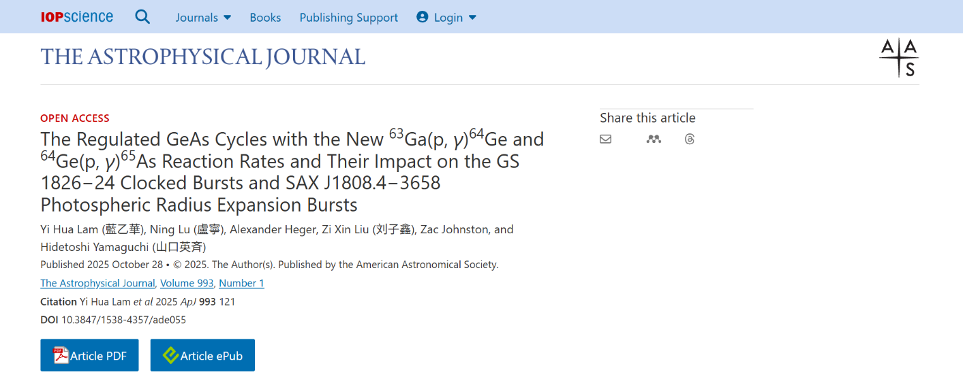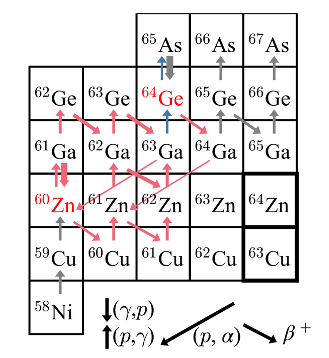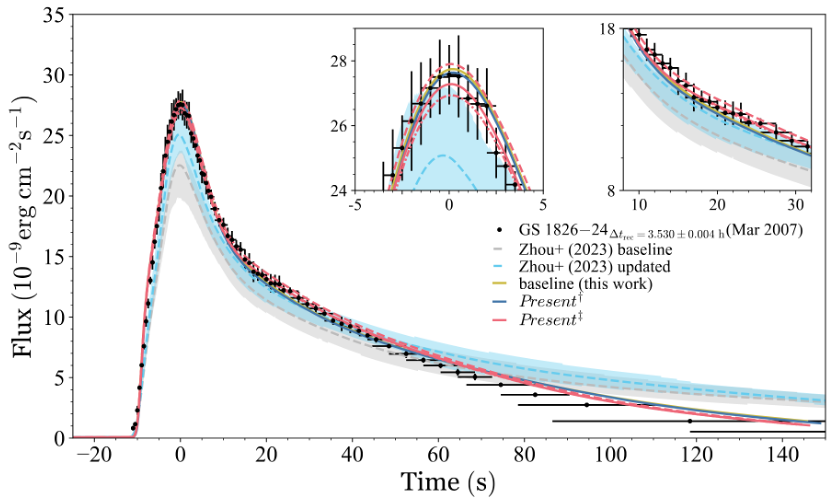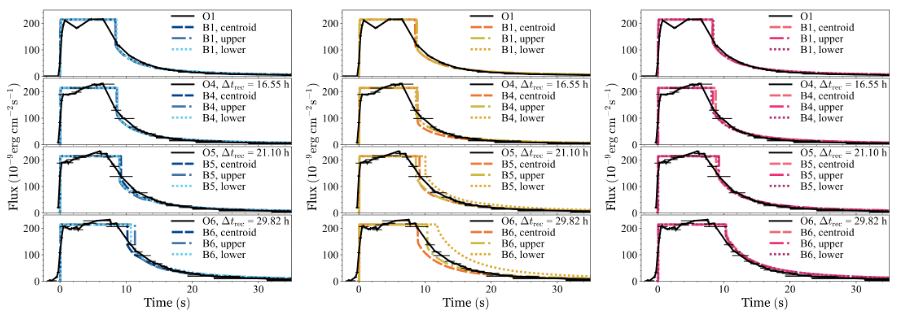近日,天文天体物理领域国际知名期刊《The Astrophysical Journal》上刊发了题为“The Regulated GeAs Cycles with the New 63Ga(p,γ)64Ge and 64Ge(p,γ)65As Reaction Rates and Its Impact on the GS 1826−24 Clocked Bursts and SAX J1808.4−3658 Photospheric Radius Expansion Bursts”的学术论文。理学院物理学系特聘教授蓝乙华为论文第一作者,浙江理工大学、全省量子物态与光场调控重点实验室为论文署名单位。该工作得到了国家自然科学基金、浙江理工大学基础研究、中国科学院国际人才等项目支持。


工作简介:
I型X射线暴源自于低质量X射线双星系统中的吸积中子星表层上方吸积包层。此类天文现象是X射线源在短时间内的X射线突然比持续辐射暴增很多倍。按理论推导,在中子星的巨大地心引力下,伴星的外层气体被吸积到中子星周围而形成吸积盘,然后该气体再从吸积盘传到中子星表层上方形成高压高温的吸积包层。在足够高温和高压强的极端天体环境下,一旦吸积包层内的氢和氦丰度达到点火阈值时,吸积包层就产生一发不可收拾的热核反应,并导致氢与氦燃烧的核过程。此类过程包括3α反应、alpha质子过程以及快质子俘获过程。这三种核过程组合成学界称之为的快质子俘获核反应路径。
在发生有高氢丰度的I型X射线暴点火时,快质子俘获核反应路径将经过铬砷循环(GeAs cycle),而该循环深受镓-63和铬-64质子俘获热核反应率影响,并且大部分的核反应流都从铬砷循环传到更重的丰质子原子核区(见图1),然后在该核区产生更多的氢燃烧。按Johnston等人的研究发现,若以氦丰度为主的I型X射线暴点火,铬砷循环以及更重核区极是快质子俘获核反应路径的终点处。因此使用精确定出的镓-63和铬-64质子俘获热核反应率将让我们更有能力重现观测X射线暴光变曲线,从而让天文天体物理学界以及核天体物理学界对时钟型及光球半径膨胀X射线暴有更深度的理解。

图1:核反应流突破锌镓循环(ZnGa cycle)示意图。通过⁶³Ga(p, γ)⁶⁴Ge(p, γ)⁶⁵As反应实现锌镓循环的突破。图中描绘反应流的箭头厚度按天体环境温度为1 GK时,标示各反应率的对数强度。锌镓循环以红色箭头标示,稳定核素以粗黑色方框表示,⁶⁰Zn和⁶⁴Ge等待点以红色文字标出。⁶³Ga(p, γ)⁶⁴Ge与⁶³Ga(p, α)⁶⁰Zn反应在⁶³Ga相互竞争。由于在温度0.5-1.6 GK范围内,⁶³Ga(p, γ)⁶⁴Ge反应率比⁶³Ga(p,α)⁶⁰Zn高出约4个数量级,核反应流主要通过⁶³Ga(p, γ)⁶⁴Ge 向⁶⁴Ge方向发散。此外,⁶⁴Ga(p, γ)⁶⁵Ge与⁶⁵Ga(p, γ)⁶⁶Ge反应也可成为通往较弱的铬砷循环的替代路径。有关弱铬砷循环的详细研究,请参见 Lam 等人(2022)的工作。
学者们通过使用精准定出的镓-63和铬-64质子俘获热核反应率(见 Lu 等人(2022)的工作),及KEPLER程序所建构的前沿周期性(GS 1826–24暴源)和光球半径膨胀(SAX J1808.4–3658暴源)X射线暴模型来研究该新反应率对光变曲线的影响。他们发现该两种新反应率对受约束的前沿周期性X射线暴模型只有可忽略的影响,并对中国科学院近代物理研究所在2023年发表在Nature Physics的结果提出质疑(图2),而该结果是基于不受严格约束的X射线暴模型求出,而且该工作只使用了新质子分离能,并没以新质子分离能求出新反应率再用到X射线暴天体模型里。虽然该两种新反应率不影响周期性X射线暴,但却对光球半径膨胀X射线暴模型有可观的影响(图3)。本研究结果也为将来修正光球半径膨胀X射线暴模型提供关键性依据。
该研究由浙江理工大学主导,联合兰州大学、中国科学院近代物理研究所、澳大利亚蒙纳士大学、美国密歇根州立大学、日本东京大学及理化学研究所共同合作完成,得到国家自然科学基金面上项目(No. 11775277)、浙江理工大学基础研究(No. 25062123-Y)和中国科学院国际人才计划 (No. 2019FYM0002) 等项目的支持。

图1:GS 1826−24时钟型爆源(2007年3月历元)的观测与模拟暴发光变曲线。黑点表示观测量。Zhou等人(2023)基于新测量的砷-65质子分离能所得出的模拟光变曲线包括:基线模型(灰色虚线)和更新模型(青色虚线)。本研究使用了最新求出的镓-63和铬-64质子俘获热核反应率(红色实线源自于中心值反应率,而红色虚线或点划线来自新反应率的上下限)。本研究发现新镓-63和铬-64质子俘获热核反应率对GS 1826−24时钟型爆源的光变曲线的影响极低。

图2:SAX J1808.4−3658(2002年10月历元)的观测与模拟光球半径膨胀暴发光变曲线。左栏:模拟光变曲线基于Johnston等人(2017)的模型构建,使用了镓-63和铬-64质子俘获热核反应率的中心值和上下限。中栏:模拟光变曲线同样基于Johnston等人的模型,采用了镓-63和铬-64质子俘获热核反应率的中心值和上下限以及实验定出的22Mg(α, p)反应率。右栏:模拟光变曲线基于修复的光球半径膨胀暴发模型生成,使用了用于中栏的反应率。左栏体现出新镓-63和铬-64质子俘获热核反应率对光球半径膨胀暴发光变曲线的明显影响。
论文信息:
Yi Hua Lam*, Ning Lu, Alexander Heger*, Zi Xin Liu, Zac Johnston, Hidetoshi Yamaguchi
The Regulated GeAs Cycles with the New 63Ga(p,γ)64Ge and 64Ge(p,γ)65As Reaction Rates and Its Impact on the GS 1826−24 Clocked Bursts and SAX J1808.4−3658 Photospheric Radius Expansion Bursts, Astrophysical Journal 993, 121 (2025).
https://doi.org/10.3847/1538-4357/ade055
供稿联系人:
藍乙華(特聘教授),
理学院物理学系,
浙江理工大学
https://lamyihua.github.io/
Proton thresholds of proton-rich arsenic and selenium really impact periodic X-ray bursts? New study puts odds on them but favors photospheric radius expansion bursts.
Scholar of Department of Physics of Zhejiang Sci-Tech University (China) and RIKEN (Japan), together with domestic collaborators of Lanzhou University and Chinese Academy of Sciences, international collaborators of Monash University (Australia), the Joint-Institute for Nuclear Astrophysics (United States), Michigan State University (United States), and the University of Tokyo (Japan) uses a significantly updated and more precise proton capture reaction rates of gallium-63 and germanium-64 to investigate the thermonuclear X-ray bursts occurring at the extreme astrophysical environments of accreting neutron stars.
Due to the enormous gravitational force of a neutron star, an extreme astrophysical environment exists at the extremely dense envelope of the neutron star that is formed from accreting stellar fuel of a companion star. Such an envelope can be up to about 6,600 times the density of the core of the sun, and 130 times its temperature. Under such extreme conditions, thermonuclear runaway can occur and release a huge amount of energy in the form of X-rays. At that moment, light nuclei are fused into heavier nuclei and then heavier nuclei capture additional protons and alpha particles, forming the so-called rapid-proton capture process path, synthesizing proton-rich nuclei along the nuclear reaction flow path. Such extreme astronomical event is called Type I X-ray burst. After an X-ray burst recedes and if the accretion of stellar fuel continues, consecutive thermonuclear bursts may occur on and off. These astrophysical phenomena occur at low-mass X-ray binaries and called “bursters”. The most investigated burster is the GS 1826–24 periodic X-ray source, and the SAX J1808.4–3658 burster gains attention from the community due to its peculiar energetic photospheric radius expansion bursts and it is the first accreting millisecond pulsar discovered in 1998 by the Italian-Dutch BeppoSAX satellite.
Recently, new proton thresholds of arsenic-65 and selenium-66 were experimentally determined by the Institute of Modern Physics (IMP), Chinese Academy of Sciences (CAS). These new proton thresholds were then shown to induce significant impact on characterizing the burst light-curve profile of the GS 1826–24 periodic burster (Nature Physics 19, 1091).
By implementing the updated and more precise proton capture reaction rates of gallium-63 and germanium-64 based on the latest proton threshold of arsenic-65 and experimental and theoretical nuclear spectroscopic information, the collaboration studied the impact of these new thermonuclear reactions on both periodic bursts of the GS 1826–24 burster (Figure 1) and photospheric radius expansion bursts of the SAX J1808.4–3658 burster (Figure 2). Both X-ray-burst models for these two bursters are constructed from the state-of-the-art self-consistent one-dimensional multi-zone thermo-hydrodynamic code, KEPLER. They found that the finding of IMP/CAS is in fact based on X-ray models that are not constrained to reproducing important observables. Reproducing observables is an important measuring yard stick to gauge the X-ray-burst models. Moreover, implementing these new proton thresholds by IMP/CAS without recalculating the respective reaction rates diminishes the reliability of their finding.

Figure 1: The observed and modeled burst light-curve profiles of the GS 1826−24 clocked burster (epoch 2007 March). The observed burst light-curve profile (black dots) is plotted against the respective modeled counterparts. Modeled light-curve profiles from IMP/CAS (2023): baseline (dashed gray line) and updated (dashed cyan line). The light-curve profiles based on the new proton capture reaction rates of gallium-63 and germanium-64 (Present‡; red solid, dashed, and dot-dashed lines). The impact of new reaction rates on burst light curves is discernible.

Figure 2: The observed and modeled PRE-burst light curves of SAX J1808.4−3658 (epoch 2002 October). Each observed burst light curve of the epoch (black lines) is plotted against the respective modeled counterparts. Left column: modeled light curves are constructed from the Johnston et al. model using the new proton capture reaction rates of gallium-63 and germanium-64. Middle column: modeled light curves yielded from the Johnston et al. model using the reactions rates for left column with new 22Mg(α, p) reaction rate. Right column: modeled light curves generated from the restored Johnston et al. model using the reaction rates for middle column.
In addition, they found that the periodic burst of GS 1826–24 burster is not sensitive to the updated gallium-63 and germanium-64 proton capture reaction rates, whereas the photospheric radius expansion bursts of the SAX J1808.4–3658 burster easily pick up the effect of these two updated reaction rates on characterizing the burst light curves, recurrence times, and burst fluences. The underlying reason is due to the role played by the new proton capture reactions of gallium-63 and germanium-64 regulates the weak GeAs cycle that is located at almost the end of the rapid-proton capture process path for photospheric radius expansion bursts when the reaction flow breaks out from the ZnGa cycle (see Figure 3). The reaction flow is either speeded up or slowed down in the GeAs cycle by these proton capture reactions, affecting the synthesis of proton-rich nuclei that are recycled to the following photospheric radius expansion bursts. The abundances of these freshly synthesized nuclei either delay or hasten the next burst, affecting the recurrence times of consecutive bursts.

Figure 3: The breakout of the ZnGa cycles via the 63Ga(p, γ)64Ge(p, γ)65As reaction. The arrows depicting the reaction flow are scaled to the logarithmic strength of the respective reaction rates at astrophysical environment of 1 GK. The ZnGa cycles are displayed as red arrows. Stable nuclei are represented by thick black squares, and the 60Zn and 64Ge waiting points are shown in red texts. Both 63Ga(p, γ)64Ge and 63Ga(p, α)60Zn reactions compete at 63Ga. The reaction flow mainly diverges out to 64Ge via 63Ga(p, γ)64Ge as the 63Ga(p, γ)64Ge reaction rate is up to 4 orders of magnitude higher than the 63Ga(p, α)60Zn reaction rate at temperature of 0.5-1.6 GK. Both 64Ga(p, γ)65Ge and 65Ga(p, γ)66Ge reactions are the alternative paths for the reaction flow to reach the weak GeAs cycles. See the detailed study on the weak GeAs cycles performed by Lam et al. (2022).
Such finding suggests the photospheric radius expansion burst model for SAX J1808.4–3658 is more sensitive to the variation of thermonuclear reactions as more direct observables like irregular light curves, non-constant recurrence times and fluences are considered in the study. Meanwhile, the matching between model and observation simultaneously takes into account these observables. The work indicates that the models reproducing the epoch 2002 October of the SAX J1808.4−3658 photospheric radius expansion burster are more sensitive to the uncertainties of thermonuclear reaction rates.
The work is supported by the National Natural Science Foundation of China (No. 11775277), Science Foundation of Zhejiang Sci-Tech University (No. 25062123-Y) and the Chinese Academy of Sciences President’s International Fellowship Initiative (No. 2019FYM0002). The computing resources, i.e., PHYS T3 cluster, Distributed Cloud resources (FDR5 cluster), provided by the Institute of Physics and Academia Sinica Grid-computing Center of Academia Sinica (ASGC; grant No. AS-CFII-112-103), Taiwan, the Yukawa-21 Supercomputer at the Yukawa Institute of Theoretical Physics (YITP) of Kyoto University, and the PC Cluster of Center for Computational Astrophysics (CfCA), National Astronomical Observatory of Japan (NAOJ) are very greatly appreciated.
A paper describing the research work has been published in The Astrophysical Journal on October 28th, 2025.
The Regulated GeAs Cycles with the New 63Ga(p,γ)64Ge and 64Ge(p,γ)65As Reaction Rates and Its Impact on the GS 1826−24 Clocked Bursts and SAX J1808.4−3658 Photospheric Radius Expansion Bursts, Astrophysical Journal 993, 121 (2025).
https://doi.org/10.3847/1538-4357/ade055
Contact person:
Yi Hua Lam,
Department of Physics,
Faculty of Science,
Zhejiang Sci-Tech University
https://lamyihua.github.io/
